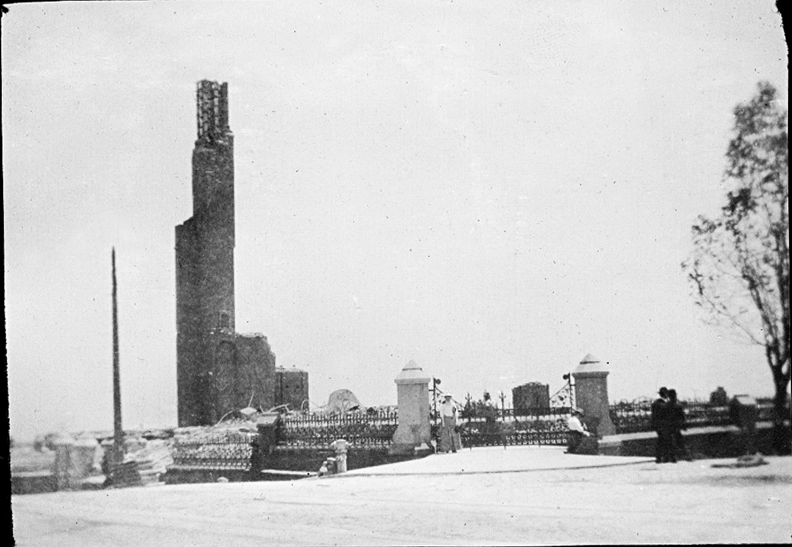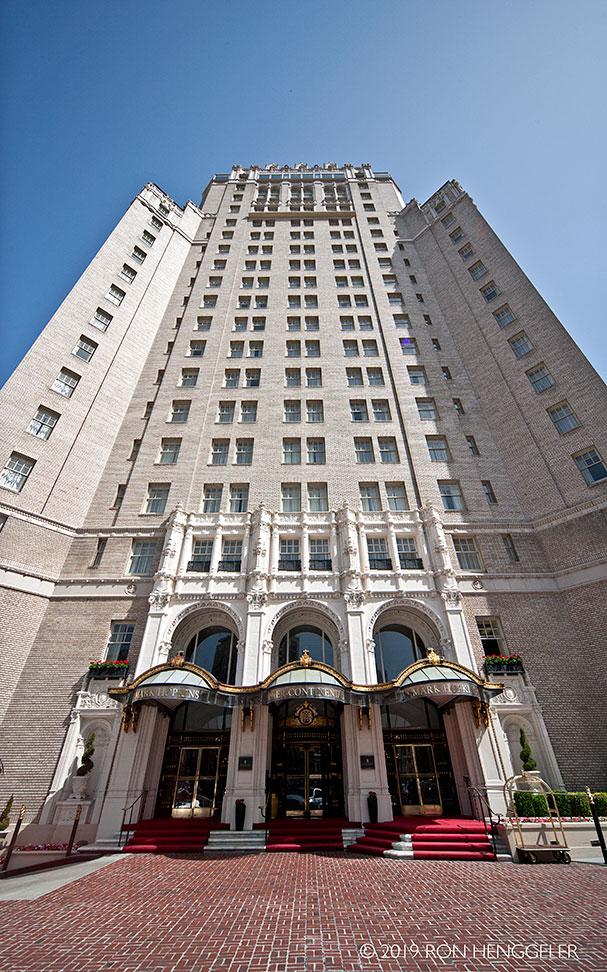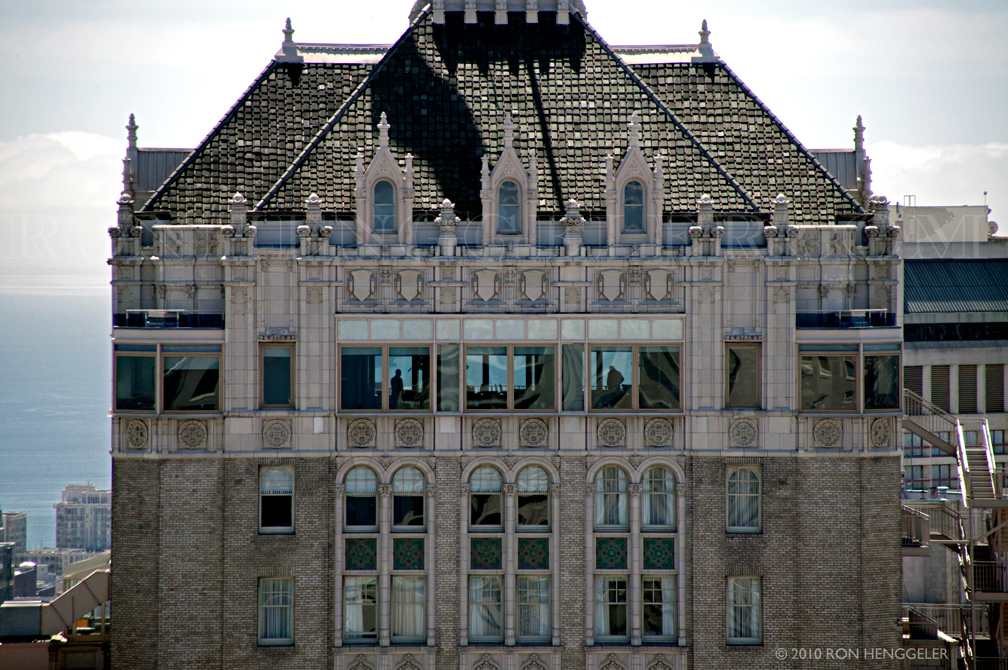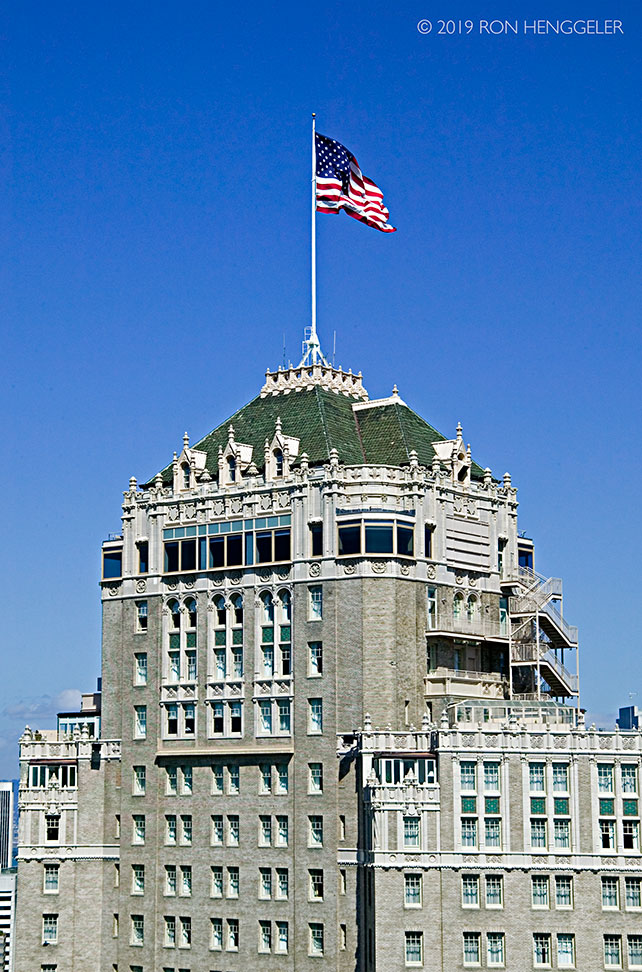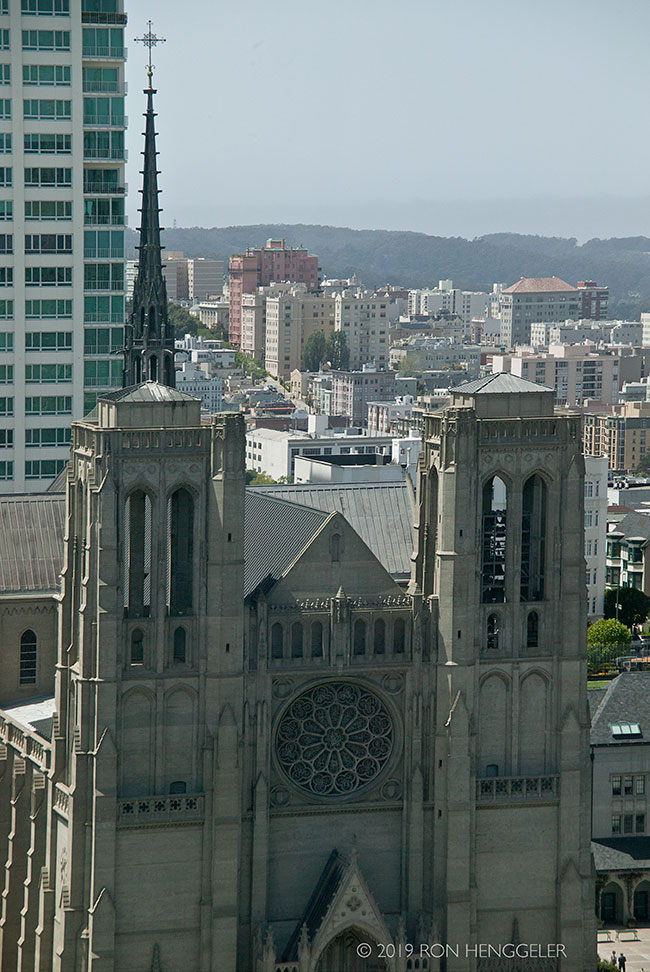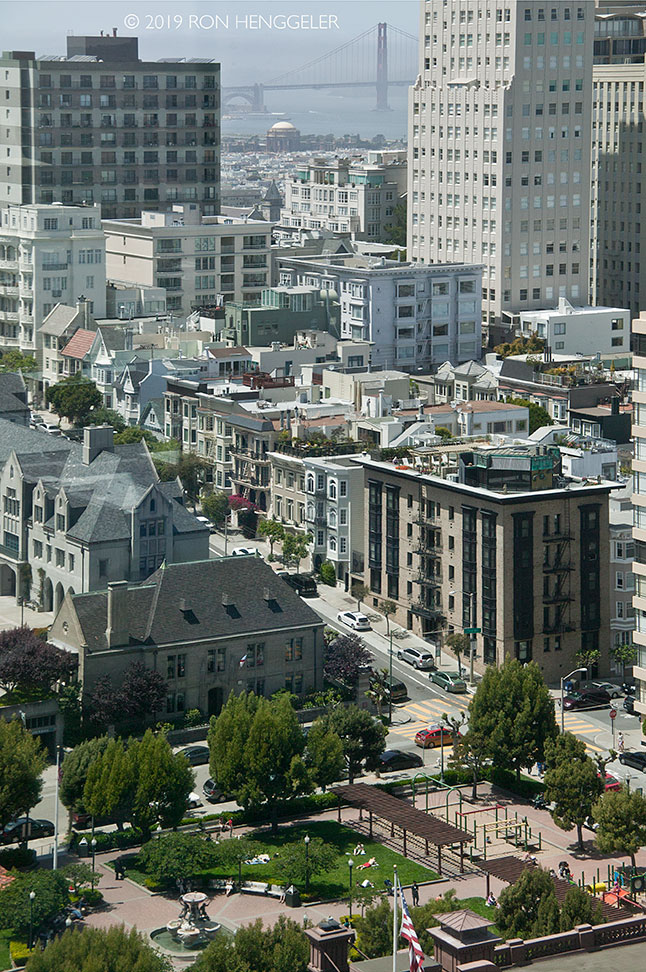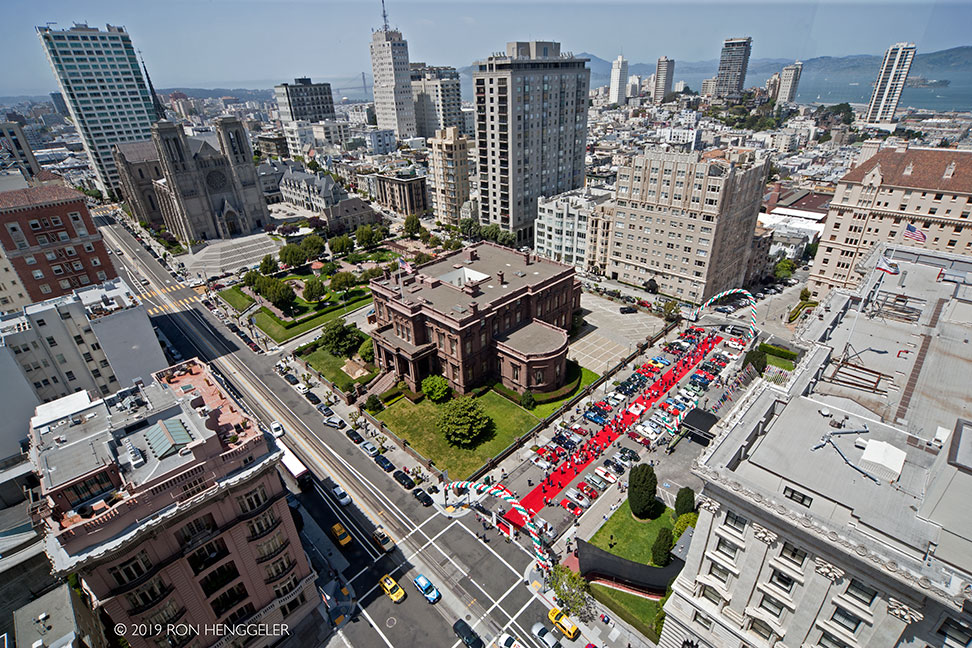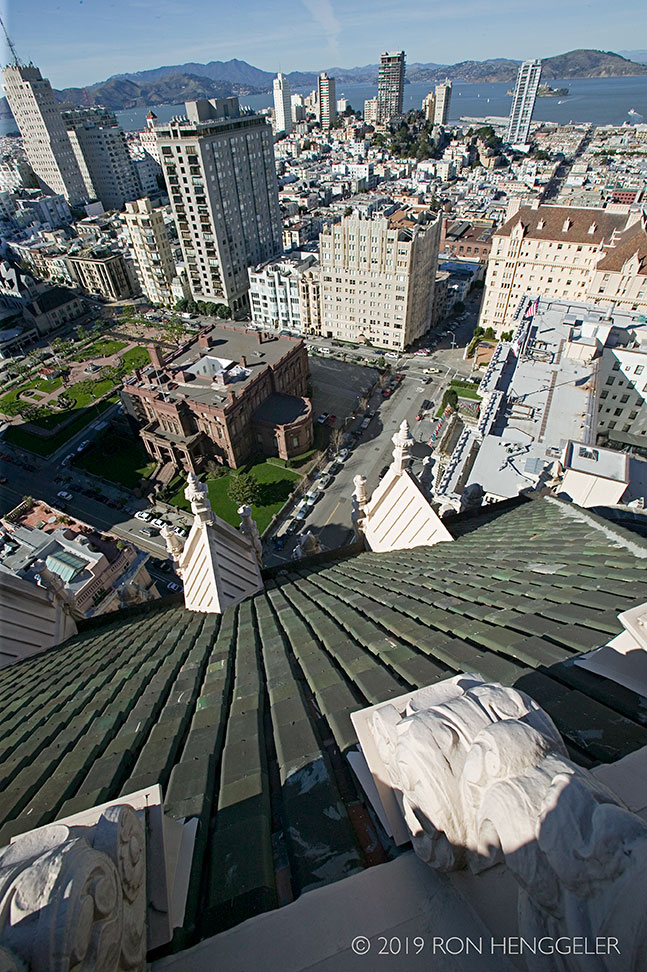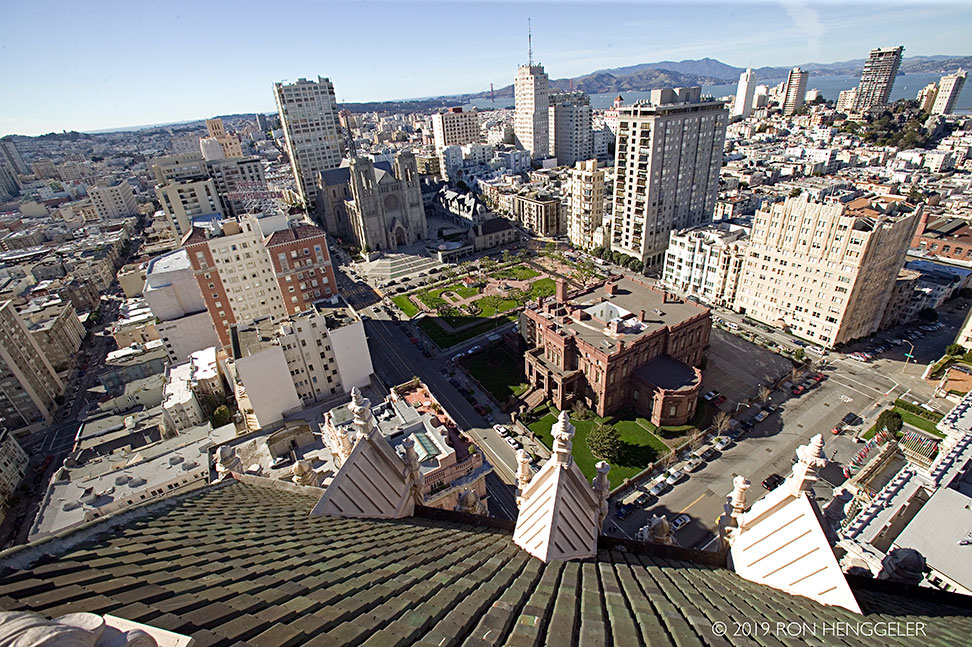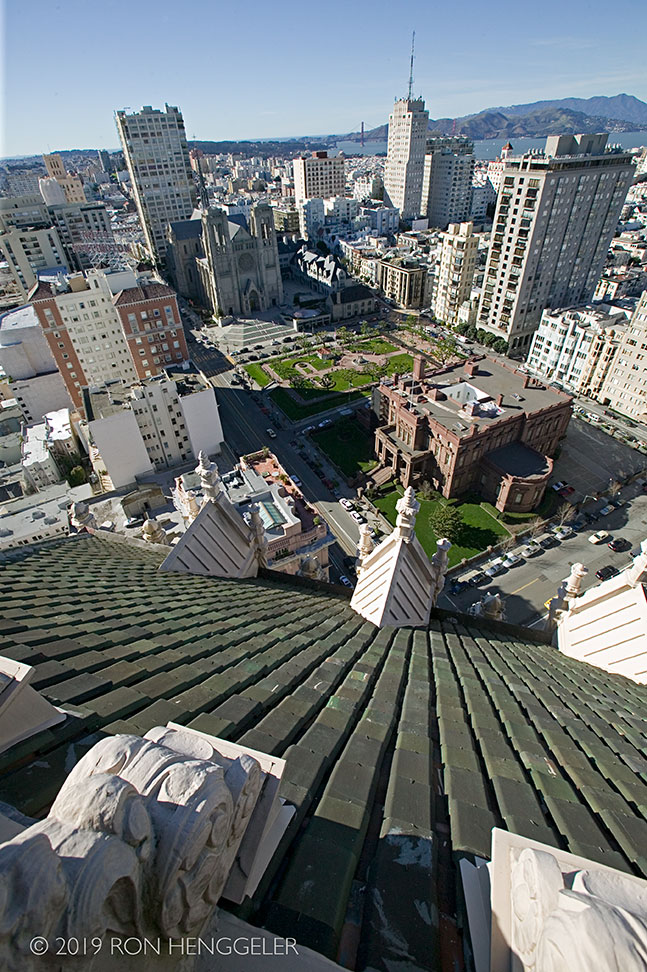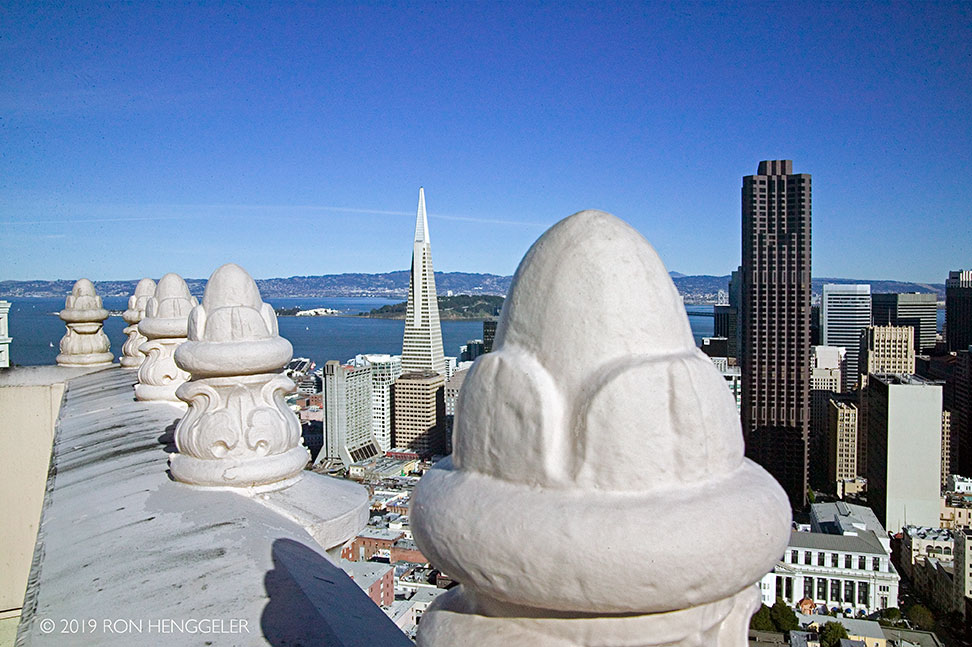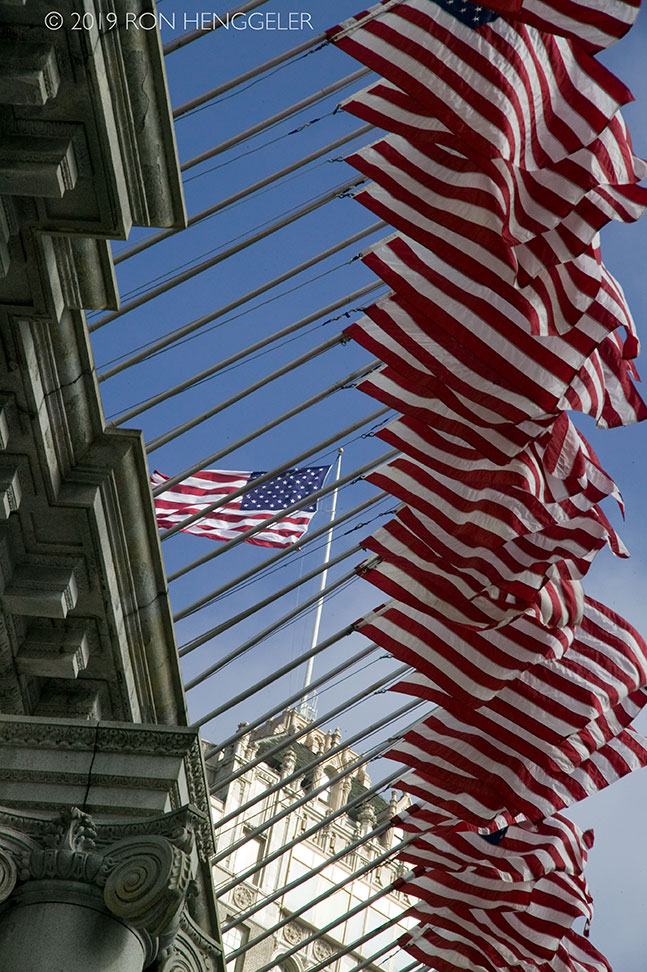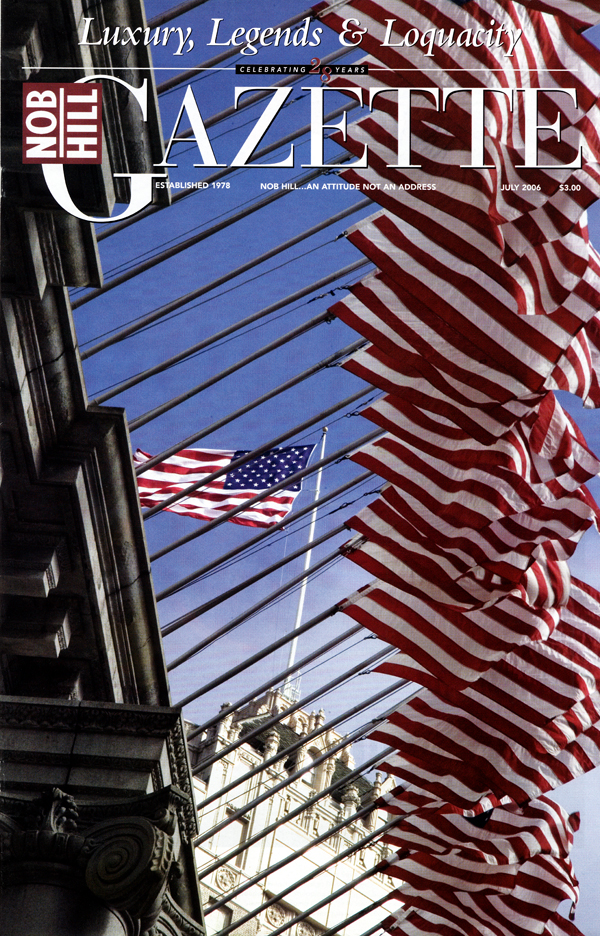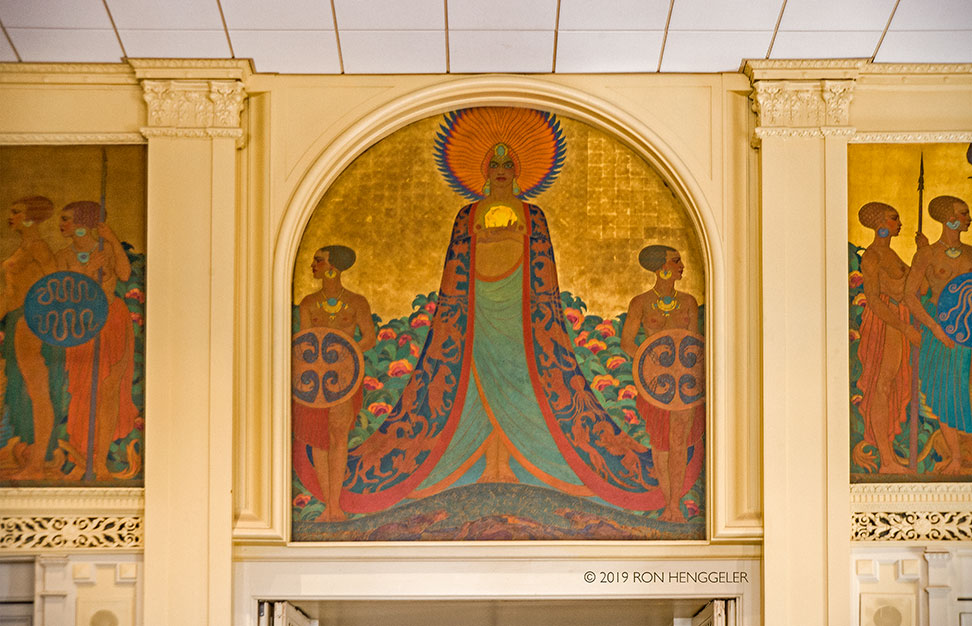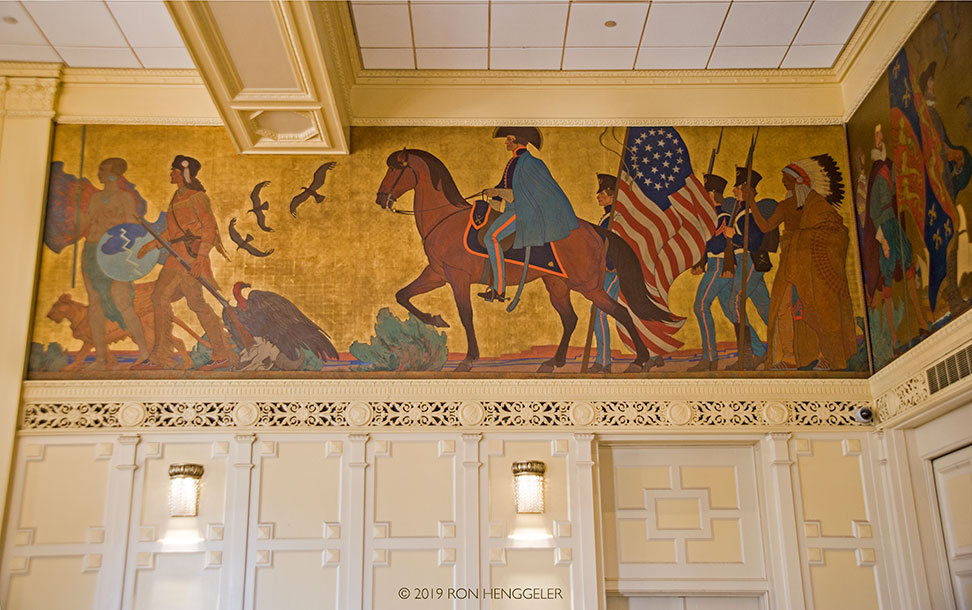RON HENGGELER |
February 9, 2019
The Mark Hopkins Intercontinental Hotel with it's Top Of The Mark, and Room of the Dons
I recently received an email from an interior designer in Nevada.
Several years ago, she had worked on remodeling some of the Mark Hopkins Intercontinental Hotel on Nob Hill in San Francisco.
She contacted me because she found an image of the hotel on my web site and asked if I had any others.
It prompted me to put together this collection of photos for her.
Mark Hopkins 1814-1878
|
The Mark Hopkins mansion stood at California and Mason Streets on Nob Hill in San Francisco. It cost three and a half million dollars to build in 1878. Notice in the bottom left corner of this photo a man is standing at the edge of a deep excavation site shored up with large timbers. At the time of this photo, the hilltop had been prepared for the construction of James Flood’s mansion (now the Pacific Union Club).
|
In 1878, when the Mark Hopkins mansion was still under construction, the photographer Eadweard Muybridge climbed into the highest top turret with his cumbersome large plate box camera and spent the better part of the day shooting his now famous panoramic view of San Francisco. To view the panorama, and learn more about Eadweard Muybridge, click here. http://www.ronhenggeler.com/History/Muybridge/muybridge_index.html
|
The rear of the Mark Hopkins mansion viewed looking north from down around Pine Street. Circa 1890’sHopkins may have had the most impressive of all the "Big Four" mansions. It was a castle, built of wood and painted to look like stone, on a scale any feudal lord would envy. The gray towers were illuminated at night and could be seen for many miles south of the City. Hopkins himself never lived there, in fact took little interest in the place as it was being built. He was happy to putter around in his vegetable garden behind the simple home he lived in down the hill. Mark Hopkins just wrote the checks, and his wife Mary, directed the construction. He gave her carte blanche, letting her indulge a passion for fanciful ornamentation that drove several designers to despair. Intricate mosaics, enormous murals, inlaid hardwoods, and lavish furnishings clashed in a wild hodge-podge of styles that could charitably be called “eclectic,”with a price tag of around three million dollars. Respectfully taken from STREET SECRETS by David B. Eames Published by Gem Guides Book Company 1995
|
Interior view of the Mark Hopkins mansion.
|
The oil portrait of Mark Hopkins is displayed on the right side of the front door of the Big 4 Restaurant. This oil painting once hung inside the Mark Hopkins mansion that burned in 1906.The previous photo above this one shows it hanging on the wall inside of the mansion, but I've never been able to find out how it survived the fire. |
This is a snapshot taken by a young girl who photographed the ruins of the burned-out Hopkins mansion. The people standing in front of the two columns are in the area that is now the entrance to the Mark Hopkins Intercontinental Hotel. |
The chimney in the center of the painting is from the burned-out Hopkins mansion, and to the left of it is the burned-out Fairmont Hotel. The Hopkins chimney appears in the previous snapshot taken by the young girl.The artist Charles Rogers painted this oil on location only three months after the earthquake and fire in 1906.Charles Rogers is looking east and standing in the stepped garden in the back yard of the burned-out Tobin mansion (now the Huntington Hotel).This stepped garden behind Tobin’s home appears clearly in the 1878 Muybridge panorama of San Francisco.The line of scorched trees in the mid ground and on the right of the frame, are the trees that grew along the granite retaining wall on Mason Street from Pine to California. Off in the distance is the East Bay and Oakland.From the perspective that Charles chose, he painted this scene from around the freight entrance and loading dock of the Huntington Hotel on Taylor Street.The iconic and famous Portals of the Past would be standing atop the retaining wall in the upper left corner, but it’s out of frame in Rogers’ chosen perspective. (See more about the Portals below)The painting is signed in the bottom left corner with the artist’s signature and the date June 1906.Here is the entry about the artist Charles Albert Rogers in the Hughes’ Compendium of California Artists.Charles Albert Rogers (1846-1918)Born in New haven CT on Feb. 26,1848. Rogers studied art in NYC for 15 years and had further training in Rome, Munich, and Paris. After 1877, he was in San Francisco where he painted portraits, landscapes, coastals, and Chinatown genre in both oil and watercolor. He exhibited at the mark Hopkins Institute in 1898 and was active in San Francisco until the 1906 earthquake. His studio at 108 Stockton Street went up in flames, taking with it 150 of his paintings, mostly scenes of the City. He then moved to Los Angeles where he exhibited at the Blanchard Building and Daniell Gallery, and maintained a studio in the Chamber of Commerce Building until about 1913. Rogers painted in Yosemite during the summer of 1911. He died in Alameda CA on April 26, 1918. Member: SFAA; Painters and Sculptors of LA; Calif. Art Club. Exh. Calif. State Fair, 1892-1902; SFAA, 1893-1916; Mechanics Inst. (SF) 1895-99; Alaska Yukon Expo(Seattle), 1909 (bronze medal); Blanchard Gallery (LA), 1911. In: CHS CD; AAA 1898; Bay of San Francisco, vol.2, p. 392; SCA; SF Chronicle, 4-28-1918 (obit).Portals of the PastPhotos 29, 30, 31, and 32 on this page.http://www.ronhenggeler.com/the_big_4/big4_index.htmThe stepped garden behind Tobin’s home appears in the Muybridge panorama.http://www.ronhenggeler.com/History/Muybridge/two.html |
|
These two brass plaques are displayed on the retaining wall in front of the Mark Hopkins Intercontinental Hotel on California Street. |
|
|
|
|
|
The Mark Hopkins Intercontinental Hotel as seen from the tenth floor of the Park Lane on Sacramento at Mason |
The historic and famous Top of the Mark on top of the Mark Hopkins Hotel(As seen from the rooftop of 1170 Sacramento with a telephoto lens) |
High atop on the roof of the Mark Hopkins Intercontinental Hotel is a crow's nest at the base of the flagpole. |
A view from the crow's nest on top of the Top of the Mark |
A view from the crow's nest on top of the Top of the Mark |
A telephoto lens view of Grace Cathedral as seen from the crow's nest on top of the Top of the Mark |
A telephoto lens view from the crow's nest on top of the Top of the Mark |
|
|
A view from the crow's nest on top of the Top of the Mark |
A view from the crow's nest on top of the Top of the Mark |
A view from the crow's nest on top of the Top of the Mark |
|
A view from the crow's nest on top of the Top of the Mark |
A view from the crow's nest on top of the Top of the Mark |
The Brocklebank as seen from the crow's nest on top of the Top of the Mark |
The Transamerica Pyramid as seen from the crow's nest on top of the Top of the Mark |
The Fairmont Crown as seen from the crow's nest on top of the Top of the Mark |
A view of the crow's nest on top of the Top of the Mark, as seen the main entrance of the Fairmont Hotel across the street. |
In July of 2006, my photo was used on the front cover of the Nob Hill Gazette.Once a year, on the Fourth of July, the Fairmont Hotel replaces the interntional flags at its entrance with only American flags. The tradition of flying the international flags throughout the year goes back to the end of World War II.For 11 weeks (mid April-June 26th) in 1945, San Francisco was the Capital of the World. Delegates from over forty nations representing eighty percent of the world population came together to write the United Nations Charter.
|
Room of the Dons at the Mark HopkinsIn the Room of the Dons at the Mark Hopkins Hotel on Nob Hill, there are nine murals depicting the legend of Queen Califia and the early history of California. They were painted by artists Maynard Dixon and Frank Van Sloun for the hotel's grand opening in 1926. |
|
Room of the DonsHere is a short podcast about the woman, Ola Carlson, who modeled for some of the figures painted by Maynard Dixon: www.facebook.com/video/video.php?v=551899486958 |
|
|
|
|
Room of the DonsHere is a short podcast about the woman, Ola Carlson, who modeled for some of the figures painted by Maynard Dixon: www.facebook.com/video/video.php?v=551899486958 |
|
|
|
|
|
|
|
|
Room of the Dons at the Mark HopkinsIn the Room of the Dons at the Mark Hopkins Hotel on Nob Hill, there are nine murals depicting the legend of Queen Califia and the early history of California. They were painted by artists Maynard Dixon and Frank Van Sloun for the hotel's grand opening in 1926. |
The Mark Hopkins Intercontinental Hotel with its Top of the Mark, as seen from the roof of the Huntington Hotel. |
Newsletters Index: 2019, 2018, 2017, 2016, 2015, 2014, 2013, 2012, 2011, 2010, 2009, 2008, 2007, 2006
Photography Index | Graphics Index | History Index
Home | Gallery | About Me | Links | Contact
© 2019 All rights reserved.
The images are not in the public domain. They are the sole property of the
artist and may not be reproduced on the Internet, sold, altered, enhanced,
modified by artificial, digital or computer imaging or in any other form
without the express written permission of the artist. Non-watermarked copies of photographs on this site can be purchased by contacting Ron.






